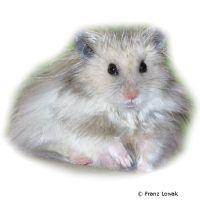Teddy Bear Hamster (Mesocricetus auratus 'Teddy')
| Teddy Bear Hamster Mesocricetus auratus 'Teddy' | |
|---|---|
| Name | Teddy Bear Hamster |
| Name Lat. | Mesocricetus auratus 'Teddy' |
| Family | Cricetid Rodents |
| Family lat. | Cricetidae |
| Order | Rodents |
| Order lat. | Rodentia |
| Origin | Middle East (breeding variety) |
| Climate | Temperate |
| Habitat | Steppe |
| Diet | Grains, herbs, hay, insects |
| Behavior | Nocturnal; territorial |
| Keeping | Individual |
| Care Level | Moderate |
| Life Span | 2-3 years |
| Protection | No |
| Metric Units | |
| Size | Up to 15 cm |
| Temperature | Room temperature |
| Housing | 100 x 50 x 50 cm |
| US Units | |
| Size | Up to 5.9" |
| Temperature | Room temperature |
| Housing | 40" x 20" x 20" |
Distribution and habitat
The nocturnal Teddy hamster is a longhaired breeding form of the golden hamster, which originated in the steppes and semi-deserts of Syria. All golden hamsters available today are descended from a family of hamsters found near Aleppo (northern Syria) in 1930.
Cage size
The enclosure size should be at least L 100 x W 50 x H 50 cm, because they move intensively during their activity phase. A rodentarium or terrarium is ideal and should be placed in a bright (no direct sunlight) and quiet place. Terrariums need ventilation openings on the sides and must not be tightly closed at the top.
Maintenance
The enclosure should be variedly structured with stones, roots and branches as well as with floors placed at different heights and offer hiding and shelter possibilities (rodent houses, tubes, clay caves etc.). They need food and drinking containers (drinking bottles), a sand bath (chinchilla sand) for grooming, nesting material (hay, pulp) and a substrate for digging. Commercially available small animal litter, hemp litter or a peat and sand mixture is suitable as a substrate. The bedding depth should be at least 30 cm. For the wear of their teeth must always be available nail material, such as untreated twigs and branches of fruit trees, and a rodent stone
They should be kept at room temperature and their natural day-night rhythm should be respected.
Diet
Their diet is mainly vegetarian, but they also need animal protein. The diet consists of a low-fat grain mixture, available in specialized stores as "hamster food", supplemented with feed hay, dried herbs, green food (root vegetables, zucchini, dandelion), occasionally live insects (grasshoppers, crickets, etc.) and, especially during pregnancy and young rearing, insect and egg food with mealybug larvae. Fruit must be offered only rarely and in very small quantities (risk of diabetes). Drinking water must always be available in hanging bottles or in stable, open containers and, like food, must be offered fresh daily
A varied diet promotes health and prevents deficiency symptoms.
Behaviour and compatibility
They are solitary animals. One can keep a litter together until sexual maturity, but the animals must be separated immediately at the first signs of incompatibility.
Reproduction and breeding
Testes can be clearly seen in sexually mature males, and the distance between the anus and the urethral opening is greater in juvenile males than in females.
For mating, the female is briefly placed with the male. After a gestation period of 16-18 days, a litter typically includes 4 young. They are born naked and blind. 20-25 days is suckled, from the 28th day the young can already be sexually mature. The life expectancy is 2-3 years.
Important
They are nocturnal and must not be disturbed during the day
Impellers must be injury-proof, have a closed running surface and back wall and a diameter of at least 25 cm. Synthetic hamster absorbent cotton is unsuitable as nesting material.
The ambient temperature must be above 10 °C, otherwise the animals will fall into a kind of torpor
They have a particularly pronounced scent gland (ventral gland) on the abdomen of the male, which secretes a yellowish secretion to mark the territory
Their cheek pouches are expandable skin sacs that serve to hoard food, but are also used to impersonate and threaten. Special attention should be paid to the length of the permanently regrowing teeth. Teeth that are too long hinder food intake. Care must be taken to ensure thorough hygiene and impurities must be removed regularly.
Further literature can be found in your pet store.
References
Text: petdata; Image: Franz Lowak
Source: W. PUSCHMANN, D. ZSCHEILE, K. ZSCHEILE (2009): Zootierhaltung - Tiere in menschlicher Obhut: Säugetiere, Harri Deutsch Verlag; BMEL (2014): Gutachten über Mindestanforderungen an die Haltung von Säugetieren
- Gemäß § 21 Abs. 5 Tierschutzgesetz idgF
